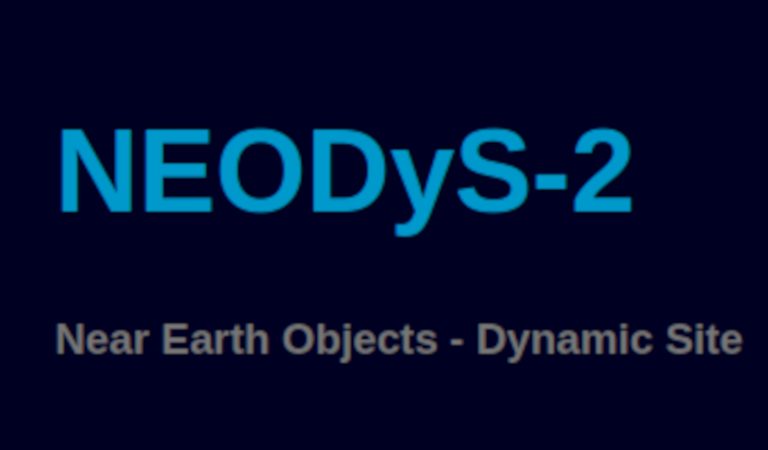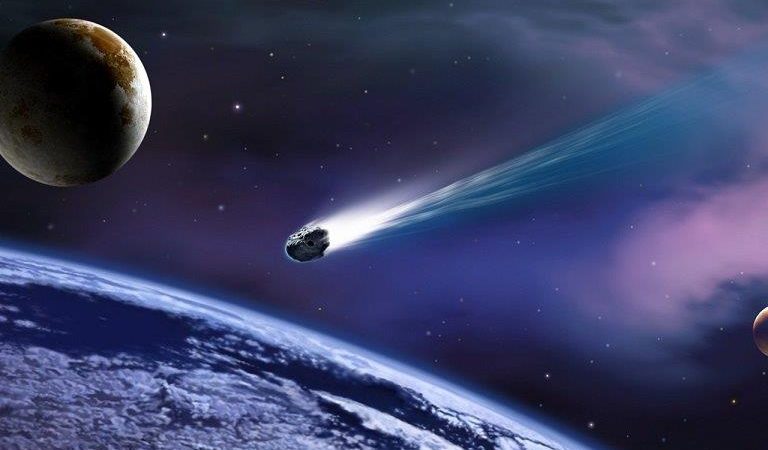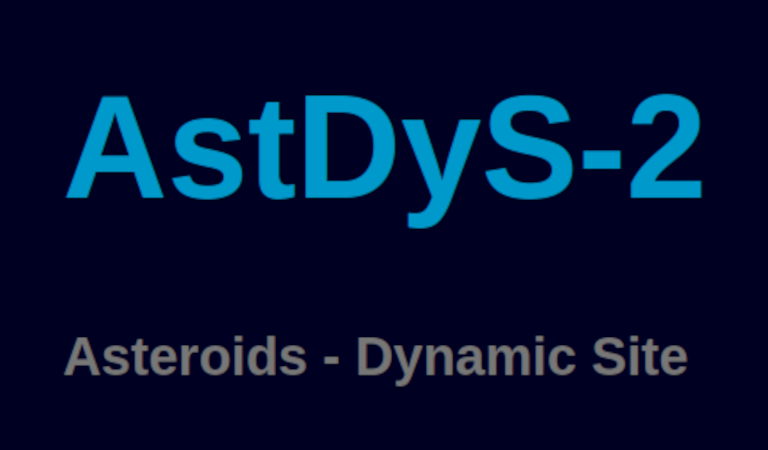
Asteroids Dynamics
SpaceDyS is one of the worldwide excellences on asteroids’dynamics. It has operated, maintained or developed two of the three Near Earth Objects impact-monitoring systems in the world: NEODyS (born at the University of Pisa and migrated to SpaceDyS) and the ESA NEO Coordination Centre Impact
Monitoring software Aegis.
SpaceDyS has the competences for precise orbit determination of such natural objects. SpaceDyS can also perform simulations and analysis for several purposes:
survey simulations, mission to asteroids…
SpaceDyS has the competences for precise orbit determination of such natural objects. SpaceDyS can also perform simulations and analysis for several purposes:
survey simulations, mission to asteroids…
NEODyS and AstDyS legacy
Prof. Milani, one of the founder of the company, was the first in the world to set up a system that systematically processes asteroids data, in particular Near Earth Objects (NEOs),in order to determine if the body is in route of collision with Earth. In 1999, this was possible thanks to his innovative method of Line of Variations. This system was called NEODyS – Near Earth Objects Dynamics Site.
Moreover, Milani and his collaborators, set up a system, called AstDyS- Asteroids Dynamics Site, which processed data and procured orbit data for all multi-opposition and numbered asteroids (now more than 1.2 millions of orbits). The uniqueness of AstDyS consists mostly on the computation of proper elements for most of these asteroids, which allows the determination of several dynamical families of the asteroids.
This long-time experience, inherited by SpaceDyS, allowed the team to be worldwide recognized for its know-how in this field and cutting-edge orbit determination methods for asteroids. It is worth to mention that the software OrbFit, developed by the University of Pisa, has been adopted by the Minor Planet Center, the international entity, supported by the International Astronomical
Moreover, Milani and his collaborators, set up a system, called AstDyS- Asteroids Dynamics Site, which processed data and procured orbit data for all multi-opposition and numbered asteroids (now more than 1.2 millions of orbits). The uniqueness of AstDyS consists mostly on the computation of proper elements for most of these asteroids, which allows the determination of several dynamical families of the asteroids.
This long-time experience, inherited by SpaceDyS, allowed the team to be worldwide recognized for its know-how in this field and cutting-edge orbit determination methods for asteroids. It is worth to mention that the software OrbFit, developed by the University of Pisa, has been adopted by the Minor Planet Center, the international entity, supported by the International Astronomical
Union, which is in charge to gather all asteroids data and that officially grants discovery credits to worldwide astronomical observations. SpaceDyS is part of the OrbFit Consortium and largely contribute to the SW maintenance and improvement. SpaceDyS, together with the University of Pisa, carried out the NEODyS and AstDyS operations and maintenance for several years. Thanks to this unique and important experience, these services were considered as strategic of ASI and ESA for the Space Situational Awareness purposes related to the NEO hazard. Therefore, SpaceDyS was involved in several activities for ESA and ASI regarding asteroids dynamics (see next sections), and consultancy on this field was requested by big companies such as OHB and PWC.
Moreover, SpaceDyS senior partners were asked to take part of international bodies regarding technical consultancy on this matter, such as the UN-COPUOS sponsored IAWN working group, the Minor Place Center User Group. Among SpaceDyS partners, there are three former presidents of International Astronomical Union – IAU commissions and one former president of IAU Division.
Moreover, SpaceDyS senior partners were asked to take part of international bodies regarding technical consultancy on this matter, such as the UN-COPUOS sponsored IAWN working group, the Minor Place Center User Group. Among SpaceDyS partners, there are three former presidents of International Astronomical Union – IAU commissions and one former president of IAU Division.
Aegis Software for ESA NEO Coordination Centre
Since foundation, the Company started to collaborate with ESA Near Earth Objects Coordination Centre (NEOCC), the operational centre of ESA’s Planetary Defence Office (PDO) within the Space Safety Programme (S2P). The NEOCC aims to coordinate and contribute to the observation of Small Solar System Bodies (SSSB) in order to evaluate and monitor the threat coming from Near-Earth Objects (NEOs). The Company was assigned several contracts to improve ESA’s capabilities to perform high accurate asteroid orbit determination computations and impact monitoring.This kind of activity is still running and will continue in the future, since ESA will maintain the NEOCC alive for several years to come, and there is no actual competitor on this task. In particular, SpaceDyS was in charge to train the ESA staff, while scientific support to the Agency was granted since 2011 throughout several contracts.
In this framework, SpaceDyS developed for ESA a new software, called Aegis, which uses a newly designed orbit propagator, while the impact monitoring computations are performed using the
In this framework, SpaceDyS developed for ESA a new software, called Aegis, which uses a newly designed orbit propagator, while the impact monitoring computations are performed using the
NEODyS algorithms. The software is fully engineered and it followed the ECSS software development guidelines. The development, the deployment and the maintenance of the software have been granted through modern CI/CD tools such as those in GitLab. Moreover, the software went through a relevant evolution from the architectural point of view. First, by harnessing Docker platform, SpaceDyS converted Aegis into a full containerised software, independent from the operational environment and made up of several self-contained units carrying out small tasks. Then, the adoption of Redis as message broker led to the asynchronous management of orbit determination and impact monitoring processes, improving the usage of cluster resources. Both of these aspects crucially contributed to the transition from the monolithic to the micro-service paradigm, which became largely exploited in the last years. The next goal in this evolution process is the transformation of Aegis into a cloud-native application, representing one of the greatest challenge of SpaceDyS for the next few years.
NEODyS and AstDyS moving to ASI
SpaceDyS has two activities concerning the future of NEODyS and AstDyS: one directly with ASI and one as subco of the University of Pisa for ASI. These contracts foresee the migration of the full systems of NEODyS and AstDyS, but, while the ordinary impact monitoring activities will be ESA responsibility at the NEO Coordination Centre, ASI will be in charge to provide other important services, such as the imminent impactors monitoring through the NEOScan service, the Priority List service, the asteroids
ephemerides provision service, the proper elements computation for NEO and the full asteroid population, and the dynamical families characterization.Moreover, the new ASi NEODyS/AstDyS environment will be used as a advanced research tool for scientists of the University of Pisa. NEODyS and AstDyS will be merged into a single portal which will be physically hosted at the ASI SSDC in Rome.
NEOROCKS
SpaceDyS has been one of the partners of the NEOROCKS consortium. This study involved several European research institutes and company and has been funded by the Horizon 2020 research and innovation programme under grant agreement No 870403. NEOROCKS stands for NEO Rapid Observation, Characterization And Key Simulation and had the purpose to improve the knowledge of the physical properties of NEOs, in particular of those which may have an imminent impact. This information is of paramount when mitigation actions are
necessary.
SpaceDyS, for this project, was responsible of the work package for the improvement of the orbit determination process from first detection until the possible impact time. For this purpose, we improved and integrated with new services, such as the New Priority List and mailing service, or the observation prediction tool for newly detected and discovered asteroids, the NEOScan module in NEODyS.
SpaceDyS, for this project, was responsible of the work package for the improvement of the orbit determination process from first detection until the possible impact time. For this purpose, we improved and integrated with new services, such as the New Priority List and mailing service, or the observation prediction tool for newly detected and discovered asteroids, the NEOScan module in NEODyS.
Associates

NEODyS
First Asteroid Impact Monitoring service in the world

Aegis
Software developed for ESA NEO Coordination Centre in Frascati (Italy). This software performs orbit determination and impact monitoring

AstDyS
AstDyS provides a huge database of asteroids’ orbits, proper elements and dynamical families info





